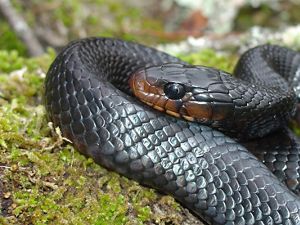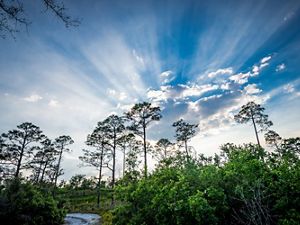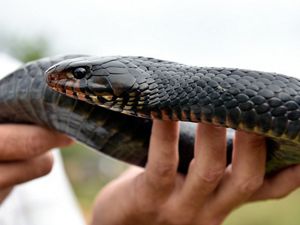19 Indigo Snakes Released in Seventh Annual Effort to Return the Important Native Species to the Region
Multiple partners continue collaboration to bring apex predator back to TNC's Apalachicola Bluffs and Ravines Preserve.
Media Contacts
-
Fran Perchick
The Nature Conservancy
Email: fran.perchick@tnc.org
Today, 19 young eastern indigo snakes were released in northern Florida, marking the seventh consecutive year of a collaborative program to return the native, non-venomous apex predator to the region. The multi-partner effort brings the snakes—listed as threatened under the Endangered Species Act—to TNC’s Apalachicola Bluffs and Ravines Preserve (ABRP) in Bristol, to continue efforts to establish a growing population to support species recovery in this ideal protected habitat.
The eastern indigo species recovery effort in North Florida is the long-term joint commitment of multiple nonprofit, agency, and academic partners including: The Nature Conservancy (TNC), the Central Florida Zoo & Botanical Gardens’ Orianne Center for Indigo Conservation (OCIC), the Florida Fish and Wildlife Conservation Commission (FWC), U.S. Fish and Wildlife Service (FWS), Welaka National Fish Hatchery, The Orianne Society, Joseph W. Jones Ecological Research Center, Southern Company through the National Fish and Wildlife Foundation (NFWF), and the Fish & Wildlife Foundation of Florida. The partners have worked together for decades to restore and manage the habitat required by the snake, and many other species, to make the release possible.
Raised specifically for release, the 19 snakes bring the total number of indigos released on the property to date to 126.
Quote: Andrew Rappe
Decades of innovative ecological restoration work at TNC's Apalachicola Bluffs and Ravines Preserve have led to this point–welcoming this keystone species back home to its native sandhill habitat.
"Decades of innovative ecological restoration work at TNC's Center for Conservation Initiatives' Apalachicola Bluffs and Ravines Preserve have led to this point, welcoming this keystone species back home to its native sandhill habitat," said Andrew Rappe, Preserve Management Director, TNC Florida.
The eastern indigo snake (Drymarchon couperi) is the longest snake native to North America and an iconic and essential component of the now rare southern longleaf pine ecosystem. It serves a critical function to balance the wildlife community by consuming a variety of small animals including both venomous and non-venomous snakes. Reaching lengths over eight feet long, the indigo often relies upon gopher tortoise burrows for shelter during cold weather. The snakes were historically found in southern Georgia, Alabama, eastern Mississippi, and throughout Florida, though their range is now far more restricted. Largely eliminated from northern Florida due to habitat loss and fragmentation, the indigo was last observed at ABRP in 1982, until the species recovery effort began in 2017.
In the past year, numerous indigos from previous releases have been observed on ABRP. Along with traditional foot surveys to monitor snakes, Michelle Hoffman (OCIC) uses trail cameras at the mouths of tortoise burrows and at intersections of fencing, some of which are paired with automatic PIT (Passive Integrated Transponder) tag readers, to detect snakes as they pass by. Trail cameras have taken hundreds of photos of indigos in various locations, including at all seven fence areas—or drift fence arrays.
ABRP is the only site in Florida currently designated for indigo reintroduction. The 6,430-acre nature preserve in northern Florida’s Liberty County protects a large longleaf pine landscape carved by numerous seepage streams and is home to the gopher tortoise and the full suite of longleaf pine specialist species. Located in the Apalachicola Bay region along the Apalachicola River, the preserve lies in the center of one of five biological hotspots in North America and is home to a great number of imperiled plants and animals. The preserve is a living laboratory for the development of restoration techniques and land management excellence. Our Center for Conservation Initiatives (CCI), brings ABRP and TNC’s other campus preserves together to advance conservation through education and training, outreach and volunteerism, science and research, innovation and land stewardship in Florida.
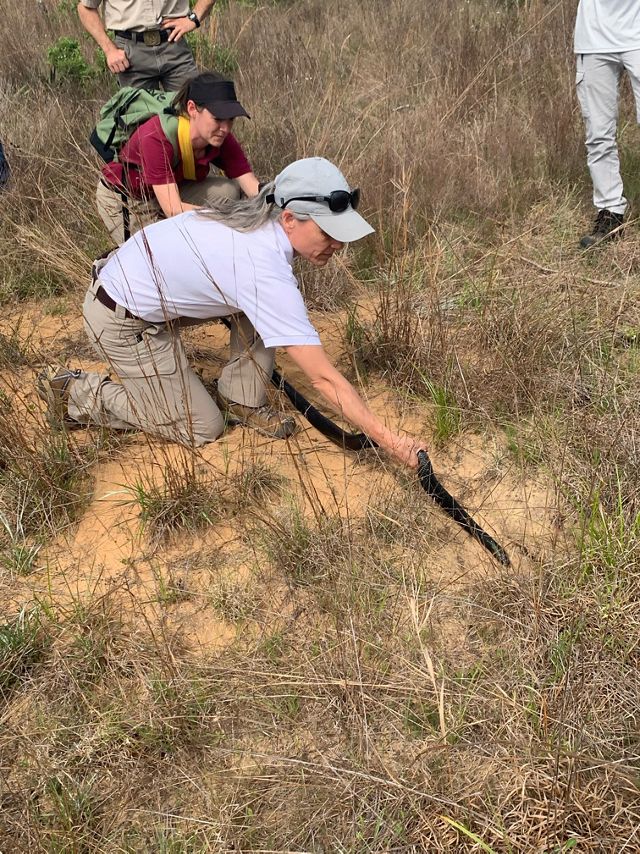
Only 5% of the longleaf pine ecosystem remains globally. Over the past 30-plus years, we have employed science and technical expertise to develop the state-of-the-art groundcover restoration process that is now used by state, federal and private partners across the southeast to restore longleaf pine habitat. This restoration, combined with our robust prescribed fire program, resulted in improved longleaf habitat on over 100,000 public and private North Florida acres in recent years. Controlled burning has been used by Native American Tribes across North America for thousands of years to encourage wild food plants, improve habitat for local animals and reduce the likelihood of destructive wildfires.
The 19 two-year-old snakes released at ABRP were bred and hatched by the Central Florida Zoo & Botanical Gardens’ Orianne Center for Indigo Conservation (OCIC), the world's foremost comprehensive-based conservation organization dedicated to the captive propagation and reintroduction of the eastern indigo snake. All hatched in 2021, the ten males and nine females were raised for one year at the OCIC and transferred to the Welaka National Fish Hatchery for an additional year in preparation for their release. The snakes have been implanted with PIT tags by the Central Florida Zoo & Botanical Gardens’ veterinary staff to allow for identification when encountered after release.
“It is bittersweet to see these young indigos released into the wild. So much effort is placed into caring for these snakes, from incubating the eggs through their first two years of care, that it is sad to see them go. It is such a good feeling, however, to see these majestic snakes in their natural environment, claiming their role as an apex predator of the longleaf pine ecosystem,” said Dr. James Bogan, Director, Orianne Center for Indigo Conservation.
The Welaka National Fish Hatchery, run by the U.S. Fish and Wildlife Service, is located along the St. Johns River in Putnam County, Florida. Known primarily for striped bass, channel catfish and bluegill, the hatchery also raises at-risk Florida grasshopper sparrows, in addition to indigo snakes. The snakes are fed a steady diet of dead mice, quail chicks and rainbow trout, and grow to about five feet in length before release.
“This year’s camera monitoring has documented dozens of snakes in several different areas on the preserve. It is so exciting to see these snakes growing and doing well,” said David Printiss, Florida Fire Program Director/North America Fire Specialist, TNC in Florida.
The indigo reintroduction efforts are supported by grants and other funding, including a Conserve Wildlife Tag Grant from the Fish & Wildlife Foundation of Florida, funded through purchase of Conserve Wildlife Florida license plates and designated for conservation of non-game species and the habitats that support them.
Quote: Dr. James Bogan
It is such a good feeling, however, to see these majestic snakes in their natural environment, claiming their role as an apex predator of the longleaf pine ecosystem.
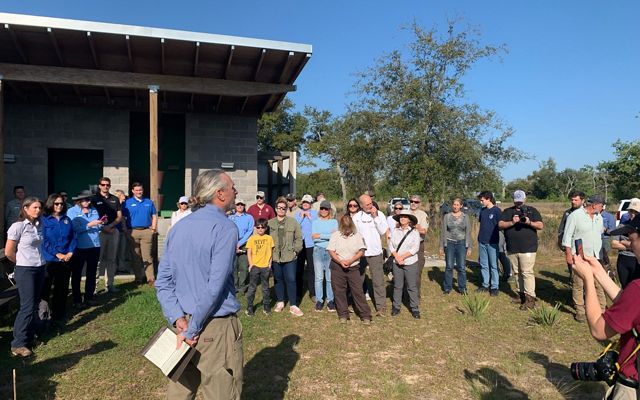
"The reintroduction of eastern indigo snakes into the Florida Panhandle is a great conservation story. It's a perfect example of why partnerships are so important to our mission, values and shared goals. The Nature Conservancy, Central Florida Zoo's Orianne Center for Indigo Conservation, the U.S. Fish and Wildlife Service, and many others, have come together to benefit this species. We are looking forward to continuing collaborative work in monitoring this new population," noted Jennifer Goff, Deputy Director of the FWC's Division of Habitat and Species Conservation.
Additional funding to support the reintroduction has been provided by Southern Company through the National Fish and Wildlife Foundation.
The Orianne Society was integral in the creation of the OCIC and the indigo snake reintroduction team and continues to play a role in reintroducing eastern indigo snakes into places they no longer occur. The Society works to conserve critical ecosystems for imperiled reptiles and amphibians, using science, applied conservation, and education.
We continue to focus on the establishment of healthy ecosystems through collaborative land, water, and wildlife conservation efforts, and throughout the state, pursues conservation projects and supports policy that protect natural systems for people and wildlife. Next year's snake release will be scheduled for spring 2024—stay tuned.
The Nature Conservancy is a global conservation organization dedicated to conserving the lands and waters on which all life depends. Guided by science, we create innovative, on-the-ground solutions to our world’s toughest challenges so that nature and people can thrive together. We are tackling climate change, conserving lands, waters and oceans at an unprecedented scale, providing food and water sustainably and helping make cities more sustainable. Working in more than 70 countries and territories, we use a collaborative approach that engages local communities, governments, the private sector, and other partners. To learn more, visit nature.org or follow @nature_press on Twitter.

